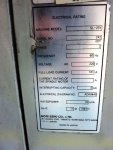delectric123
Senior Member
- Location
- South Dakota
Its been awhile since I had to calculate circuit requirements so I'm a bit rusty. Trying to determine correct circuit ampacity requirements without overkill. The specs are confusing as they use different terminology and voltage. This is a CNC lathe with multiple motors. The 35 kva does not match the 220 volts x 101 amps(38,485 va)
101 x 1.25 amps requires 1 awg copper , but that 101 amps technically makes a 125 amp breaker insufficient. but doing 38,485 va with 230v brings 96.6 amps which makes me good to go
Or should I just use the 35 kva?
Can someone direct me the correct path for calculating this? thanks.

101 x 1.25 amps requires 1 awg copper , but that 101 amps technically makes a 125 amp breaker insufficient. but doing 38,485 va with 230v brings 96.6 amps which makes me good to go
Or should I just use the 35 kva?
Can someone direct me the correct path for calculating this? thanks.


